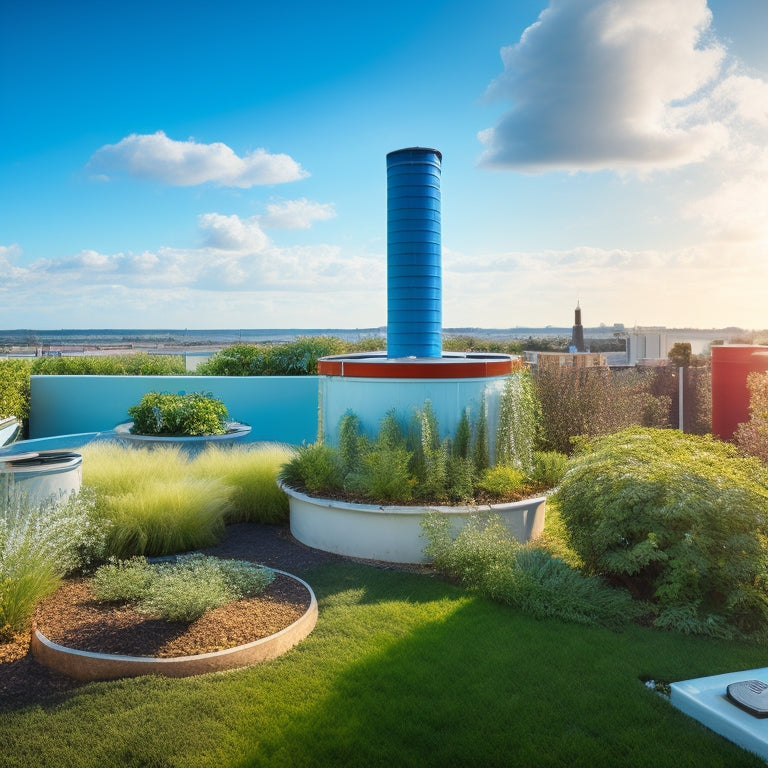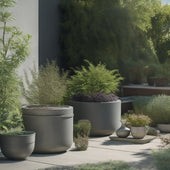
5 Best Rooftop Rainwater Harvesting Systems for Gardening
Share
You're seeking a rooftop rainwater harvesting system that can effectively gather, filter, and distribute rainwater to your garden, reducing your dependence on municipal water and promoting a sustainable gardening practice. A top system features clean gutters, advanced filtration, and efficient connections from roof to tank. It also includes smart water distribution networks and advanced overflow management solutions. These components work together to ensure you're receiving the appropriate amount of water to your plants at the correct time, while minimizing waste and damage. By incorporating these key components, you'll be well on your way to a flourishing, water-efficient garden - and there's more to explore.
Key Takeaways
• A suitable rainwater collection system channels water from the rooftop to a storage tank, promoting sustainable gardening and reducing municipal water reliance.
• Advanced filtration systems treat collected rainwater, removing impurities and contaminants, to ensure safe and healthy water for the garden ecosystem.
• Efficient roof-to-tank connections prevent water loss, reduce maintenance, and optimize storage, featuring durable and corrosion-resistant components.
• Smart water distribution networks convey rainwater efficiently, ensuring each plant receives the right amount of water at the right time, and minimizing waste.
• Advanced overflow management solutions divert excess water safely, complying with local regulations, and maximizing water storage while minimizing waste.
Rainwater Collection and Storage
You'll need a suitable rainwater collection system to channel rainwater from your rooftop to a storage tank, which is typically the first component of a rooftop rainwater harvesting system for gardening.
This system consists of gutters and downspouts that collect and transport rainwater from your rooftop to the storage tank. It's crucial to make sure that your gutters are clean and free of debris to prevent clogging and contamination of the collected water.
The storage tank should be sized appropriately based on your rooftop's surface area, rainfall intensity, and garden irrigation needs. A well-designed rainwater collection and storage system can provide a reliable source of water for your garden, reducing your reliance on municipal water supplies and promoting sustainable gardening practices.
Innovative Water Filtering Systems
Once the rainwater is collected and stored, it's time to treat it with innovative water filtering systems that remove impurities, sediment, and contaminants, guaranteeing the water is safe and healthy for your garden's ecosystem.
As a gardener, you want to provide your plants with the best possible water quality, and that's where advanced filtration technology comes in. By incorporating these systems into your rooftop rainwater harvesting setup, you'll be able to enjoy the benefits of sustainable gardening while promoting urban agriculture and water conservation.
Here are some key features to look for in an innovative water filtering system:
- Multi-stage filtration: Remove impurities down to 0.2 microns for crystal-clear water
- UV treatment: Eliminate bacteria, viruses, and other microorganisms
- Activated carbon filtration: Remove chlorine, heavy metals, and other contaminants
- Automatic backwashing: Guarantee consistent water quality and system maintenance.
Efficient Roof-to-Tank Connections
With a reliable filtration system in place, efficiently connecting your rooftop rainwater harvesting system to your storage tank is important to guarantee a seamless and consistent water supply for your garden. This connection is essential to confirm that the harvested rainwater is safely and efficiently stored for future use. A well-designed roof-to-tank connection system prevents water loss, reduces maintenance, and optimizes water storage.
| Roof-to-Tank Connection Component | Function |
|---|---|
| Roof Catchment System | Collects and channels rainwater from rooftop to downspout |
| Downspout Diverter | Diverts rainwater from downspout to storage tank |
| Tank Inlet/Outlet | Regulates water flow in and out of storage tank |
When designing your roof-to-tank connection, consider factors such as rooftop drainage, tank maintenance, and water flow rates. Confirm that your connection system is durable, resistant to corrosion, and easy to inspect and maintain. By optimizing your roof-to-tank connection, you'll enjoy a reliable and consistent water supply for your garden, giving you the freedom to focus on what matters most – nurturing your plants and enjoying the fruits of your labor.
Smart Water Distribution Networks
A well-designed smart water distribution network efficiently conveys harvested rainwater from your storage tank to your garden, making certain that every plant receives the right amount of water at the right time.
This advanced system allows you to make the most of your rooftop rainwater harvesting system, maximizing water conservation and minimizing waste.
With a smart water distribution network, you'll enjoy:
-
Real-time monitoring: Remote monitoring capabilities let you keep an eye on your water levels, flow rates, and system performance from anywhere, at any time.
-
Optimized irrigation: Advanced sensor technology and irrigation optimization algorithms ensure that your plants receive precisely the right amount of water, reducing evaporation and runoff.
-
Automated alerts: Get notified instantly if there's an issue with your system, so you can take action before it's too late.
- Data-driven insights: Gain valuable insights into your water usage and system performance, helping you refine your gardening strategy and make data-informed decisions.
Advanced Overflow Management Solutions
Your rooftop rainwater harvesting system's advanced overflow management solutions guarantee that excess water is safely diverted, preventing damage to your property, surrounding landscapes, and nearby waterways, while also helping you comply with local regulations and ordinances.
This is particularly vital for rooftop gardens, where overflow prevention is essential to maintain a thriving and sustainable green space. Advanced overflow management solutions ensure that excess water is redirected away from your property, reducing the risk of waterlogging, erosion, and structural damage.
These solutions are designed to work in conjunction with your rainwater collection system, allowing you to maximize water storage capacity while minimizing waste. By incorporating sustainable landscaping practices, you can create a holistic water management system that not only reduces your environmental footprint but also enhances the aesthetic value of your property.
With advanced overflow management solutions, you can rest assured that your rooftop rainwater harvesting system is working efficiently and effectively, giving you the freedom to focus on what matters most – nurturing your garden and enjoying the fruits of your labor.
Frequently Asked Questions
Can Rooftop Rainwater Harvesting Systems Be Used in Areas With Low Rainfall?
You can still utilize rooftop rainwater harvesting systems in low-rainfall areas by incorporating drought-resistant plants and efficient rainwater collection methods, promoting sustainable urban agriculture and water solutions that give you freedom from reliance on municipal water supplies.
Are Rooftop Rainwater Harvesting Systems Compatible With All Types of Roofs?
As you gaze up at your rooftop, imagine the rainwater flowing seamlessly into a harvesting system. However, you'll need to contemplate whether your roof material and installation can support it, factoring in climate and water availability.
Do Rooftop Rainwater Harvesting Systems Require Regular Maintenance?
You'll need to perform regular maintenance on your rooftop rainwater harvesting system, typically every 3-6 months, to guarantee peak efficiency and durability, which pays off with extended system lifespan and reduced repair costs.
Can Harvested Rainwater Be Used for Indoor Household Purposes?
You'll be surprised to know that a single inch of rainfall can collect up to 600 gallons of water! As you consider using harvested rainwater for indoor household purposes, you'll need to invest in indoor filtration systems to guarantee water quality, employing treatment methods like UV, sedimentation, or distillation.
Are Rooftop Rainwater Harvesting Systems Cost-Effective in the Long Run?
You'll find that investing in a rooftop rainwater harvesting system pays off in the long run, yielding significant environmental benefits, cost savings, and promoting sustainability and water conservation, giving you the freedom to live more eco-friendly.
Related Posts
-

10 Essential Soil Tips for DIY Planters
You can greatly improve your DIY planter's chances of success by understanding and implementing the essential soil ti...
-

10 Essential Soil Tips for DIY Planters
You can greatly improve your DIY planter's chances of success by understanding and implementing the essential soil ti...
-

10 Essential Soil Tips for DIY Planters
You can greatly improve your DIY planter's chances of success by understanding and implementing the essential soil ti...
-

10 Essential Soil Tips for DIY Planters
You can greatly improve your DIY planter's chances of success by understanding and implementing the essential soil ti...
-

10 Essential Soil Tips for DIY Planters
You can greatly improve your DIY planter's chances of success by understanding and implementing the essential soil ti...
-

10 Essential Soil Tips for DIY Planters
You can greatly improve your DIY planter's chances of success by understanding and implementing the essential soil ti...
-

10 Essential Soil Tips for DIY Planters
You can greatly improve your DIY planter's chances of success by understanding and implementing the essential soil ti...
-

10 Essential Soil Tips for DIY Planters
You can greatly improve your DIY planter's chances of success by understanding and implementing the essential soil ti...
-

10 Essential Soil Tips for DIY Planters
You can greatly improve your DIY planter's chances of success by understanding and implementing the essential soil ti...
-

10 Essential Soil Tips for DIY Planters
You can greatly improve your DIY planter's chances of success by understanding and implementing the essential soil ti...
-

10 Essential Soil Tips for DIY Planters
You can greatly improve your DIY planter's chances of success by understanding and implementing the essential soil ti...
-

10 Essential Soil Tips for DIY Planters
You can greatly improve your DIY planter's chances of success by understanding and implementing the essential soil ti...
-

10 Essential Soil Tips for DIY Planters
You can greatly improve your DIY planter's chances of success by understanding and implementing the essential soil ti...
-

10 Essential Soil Tips for DIY Planters
You can greatly improve your DIY planter's chances of success by understanding and implementing the essential soil ti...
-

10 Essential Soil Tips for DIY Planters
You can greatly improve your DIY planter's chances of success by understanding and implementing the essential soil ti...
-

10 Essential Soil Tips for DIY Planters
You can greatly improve your DIY planter's chances of success by understanding and implementing the essential soil ti...
-

10 Essential Soil Tips for DIY Planters
You can greatly improve your DIY planter's chances of success by understanding and implementing the essential soil ti...
-

10 Essential Soil Tips for DIY Planters
You can greatly improve your DIY planter's chances of success by understanding and implementing the essential soil ti...
-

10 Essential Soil Tips for DIY Planters
You can greatly improve your DIY planter's chances of success by understanding and implementing the essential soil ti...
-

10 Essential Soil Tips for DIY Planters
You can greatly improve your DIY planter's chances of success by understanding and implementing the essential soil ti...
-

10 Essential Soil Tips for DIY Planters
You can greatly improve your DIY planter's chances of success by understanding and implementing the essential soil ti...
-

10 Essential Soil Tips for DIY Planters
You can greatly improve your DIY planter's chances of success by understanding and implementing the essential soil ti...
-

10 Essential Soil Tips for DIY Planters
You can greatly improve your DIY planter's chances of success by understanding and implementing the essential soil ti...
-

10 Essential Soil Tips for DIY Planters
You can greatly improve your DIY planter's chances of success by understanding and implementing the essential soil ti...
-

10 Essential Soil Tips for DIY Planters
You can greatly improve your DIY planter's chances of success by understanding and implementing the essential soil ti...
-

10 Essential Soil Tips for DIY Planters
You can greatly improve your DIY planter's chances of success by understanding and implementing the essential soil ti...
-

10 Essential Soil Tips for DIY Planters
You can greatly improve your DIY planter's chances of success by understanding and implementing the essential soil ti...
-

10 Essential Soil Tips for DIY Planters
You can greatly improve your DIY planter's chances of success by understanding and implementing the essential soil ti...
-

10 Essential Soil Tips for DIY Planters
You can greatly improve your DIY planter's chances of success by understanding and implementing the essential soil ti...
-

10 Essential Soil Tips for DIY Planters
You can greatly improve your DIY planter's chances of success by understanding and implementing the essential soil ti...
-

10 Essential Soil Tips for DIY Planters
You can greatly improve your DIY planter's chances of success by understanding and implementing the essential soil ti...
-

10 Essential Soil Tips for DIY Planters
You can greatly improve your DIY planter's chances of success by understanding and implementing the essential soil ti...
-

10 Essential Soil Tips for DIY Planters
You can greatly improve your DIY planter's chances of success by understanding and implementing the essential soil ti...
-

10 Essential Soil Tips for DIY Planters
You can greatly improve your DIY planter's chances of success by understanding and implementing the essential soil ti...
-

10 Essential Soil Tips for DIY Planters
You can greatly improve your DIY planter's chances of success by understanding and implementing the essential soil ti...
-

10 Essential Soil Tips for DIY Planters
You can greatly improve your DIY planter's chances of success by understanding and implementing the essential soil ti...
-

10 Essential Soil Tips for DIY Planters
You can greatly improve your DIY planter's chances of success by understanding and implementing the essential soil ti...
-

Accurate Measuring for DIY Block Planters Made Easy
As you begin building a DIY block planter, precise measurement is essential for a sturdy structure that can support s...
-

Accurate Measuring for DIY Block Planters Made Easy
As you begin building a DIY block planter, precise measurement is essential for a sturdy structure that can support s...
-

Accurate Measuring for DIY Block Planters Made Easy
As you begin building a DIY block planter, precise measurement is essential for a sturdy structure that can support s...
-

Accurate Measuring for DIY Block Planters Made Easy
As you begin building a DIY block planter, precise measurement is essential for a sturdy structure that can support s...
-

Accurate Measuring for DIY Block Planters Made Easy
As you begin building a DIY block planter, precise measurement is essential for a sturdy structure that can support s...
-

Accurate Measuring for DIY Block Planters Made Easy
As you begin building a DIY block planter, precise measurement is essential for a sturdy structure that can support s...
-

Accurate Measuring for DIY Block Planters Made Easy
As you begin building a DIY block planter, precise measurement is essential for a sturdy structure that can support s...
-

Accurate Measuring for DIY Block Planters Made Easy
As you begin building a DIY block planter, precise measurement is essential for a sturdy structure that can support s...
-

Accurate Measuring for DIY Block Planters Made Easy
As you begin building a DIY block planter, precise measurement is essential for a sturdy structure that can support s...
-

Accurate Measuring for DIY Block Planters Made Easy
As you begin building a DIY block planter, precise measurement is essential for a sturdy structure that can support s...
-

Accurate Measuring for DIY Block Planters Made Easy
As you begin building a DIY block planter, precise measurement is essential for a sturdy structure that can support s...
-

Accurate Measuring for DIY Block Planters Made Easy
As you begin building a DIY block planter, precise measurement is essential for a sturdy structure that can support s...
-

Accurate Measuring for DIY Block Planters Made Easy
As you begin building a DIY block planter, precise measurement is essential for a sturdy structure that can support s...
-

Accurate Measuring for DIY Block Planters Made Easy
As you begin building a DIY block planter, precise measurement is essential for a sturdy structure that can support s...
-

Accurate Measuring for DIY Block Planters Made Easy
As you begin building a DIY block planter, precise measurement is essential for a sturdy structure that can support s...
-

Accurate Measuring for DIY Block Planters Made Easy
As you begin building a DIY block planter, precise measurement is essential for a sturdy structure that can support s...
-

Accurate Measuring for DIY Block Planters Made Easy
As you begin building a DIY block planter, precise measurement is essential for a sturdy structure that can support s...
-

Accurate Measuring for DIY Block Planters Made Easy
As you begin building a DIY block planter, precise measurement is essential for a sturdy structure that can support s...
-

Accurate Measuring for DIY Block Planters Made Easy
As you begin building a DIY block planter, precise measurement is essential for a sturdy structure that can support s...
-

Accurate Measuring for DIY Block Planters Made Easy
As you begin building a DIY block planter, precise measurement is essential for a sturdy structure that can support s...
-

Accurate Measuring for DIY Block Planters Made Easy
As you begin building a DIY block planter, precise measurement is essential for a sturdy structure that can support s...
-

Accurate Measuring for DIY Block Planters Made Easy
As you begin building a DIY block planter, precise measurement is essential for a sturdy structure that can support s...
-

Accurate Measuring for DIY Block Planters Made Easy
As you begin building a DIY block planter, precise measurement is essential for a sturdy structure that can support s...
-

Accurate Measuring for DIY Block Planters Made Easy
As you begin building a DIY block planter, precise measurement is essential for a sturdy structure that can support s...
-

Accurate Measuring for DIY Block Planters Made Easy
As you begin building a DIY block planter, precise measurement is essential for a sturdy structure that can support s...
-

Accurate Measuring for DIY Block Planters Made Easy
As you begin building a DIY block planter, precise measurement is essential for a sturdy structure that can support s...
-

Accurate Measuring for DIY Block Planters Made Easy
As you begin building a DIY block planter, precise measurement is essential for a sturdy structure that can support s...
-

Summer Care Tips for Concrete Planters
As you step into the warmest season of the year, your concrete planters require deliberate care to thrive. Clean your...
-

Summer Care Tips for Concrete Planters
As you step into the warmest season of the year, your concrete planters require deliberate care to thrive. Clean your...
-

Summer Care Tips for Concrete Planters
As you step into the warmest season of the year, your concrete planters require deliberate care to thrive. Clean your...
-

Summer Care Tips for Concrete Planters
As you step into the warmest season of the year, your concrete planters require deliberate care to thrive. Clean your...
-

Summer Care Tips for Concrete Planters
As you step into the warmest season of the year, your concrete planters require deliberate care to thrive. Clean your...
-

Summer Care Tips for Concrete Planters
As you step into the warmest season of the year, your concrete planters require deliberate care to thrive. Clean your...
-

Summer Care Tips for Concrete Planters
As you step into the warmest season of the year, your concrete planters require deliberate care to thrive. Clean your...
-

Summer Care Tips for Concrete Planters
As you step into the warmest season of the year, your concrete planters require deliberate care to thrive. Clean your...
-

Summer Care Tips for Concrete Planters
As you step into the warmest season of the year, your concrete planters require deliberate care to thrive. Clean your...
-

Summer Care Tips for Concrete Planters
As you step into the warmest season of the year, your concrete planters require deliberate care to thrive. Clean your...
-

Summer Care Tips for Concrete Planters
As you step into the warmest season of the year, your concrete planters require deliberate care to thrive. Clean your...
-

Summer Care Tips for Concrete Planters
As you step into the warmest season of the year, your concrete planters require deliberate care to thrive. Clean your...
-

Summer Care Tips for Concrete Planters
As you step into the warmest season of the year, your concrete planters require deliberate care to thrive. Clean your...
-

Summer Care Tips for Concrete Planters
As you step into the warmest season of the year, your concrete planters require deliberate care to thrive. Clean your...
-

Summer Care Tips for Concrete Planters
As you step into the warmest season of the year, your concrete planters require deliberate care to thrive. Clean your...
-

Summer Care Tips for Concrete Planters
As you step into the warmest season of the year, your concrete planters require deliberate care to thrive. Clean your...
-

Summer Care Tips for Concrete Planters
As you step into the warmest season of the year, your concrete planters require deliberate care to thrive. Clean your...
-

Summer Care Tips for Concrete Planters
As you step into the warmest season of the year, your concrete planters require deliberate care to thrive. Clean your...
-

Summer Care Tips for Concrete Planters
As you step into the warmest season of the year, your concrete planters require deliberate care to thrive. Clean your...
-

Summer Care Tips for Concrete Planters
As you step into the warmest season of the year, your concrete planters require deliberate care to thrive. Clean your...
-

Summer Care Tips for Concrete Planters
As you step into the warmest season of the year, your concrete planters require deliberate care to thrive. Clean your...
-

Summer Care Tips for Concrete Planters
As you step into the warmest season of the year, your concrete planters require deliberate care to thrive. Clean your...
-

Summer Care Tips for Concrete Planters
As you step into the warmest season of the year, your concrete planters require deliberate care to thrive. Clean your...
-

Summer Care Tips for Concrete Planters
As you step into the warmest season of the year, your concrete planters require deliberate care to thrive. Clean your...
-

Summer Care Tips for Concrete Planters
As you step into the warmest season of the year, your concrete planters require deliberate care to thrive. Clean your...
-

Summer Care Tips for Concrete Planters
As you step into the warmest season of the year, your concrete planters require deliberate care to thrive. Clean your...
-

Summer Care Tips for Concrete Planters
As you step into the warmest season of the year, your concrete planters require deliberate care to thrive. Clean your...
-

Summer Care Tips for Concrete Planters
As you step into the warmest season of the year, your concrete planters require deliberate care to thrive. Clean your...
-

Summer Care Tips for Concrete Planters
As you step into the warmest season of the year, your concrete planters require deliberate care to thrive. Clean your...


